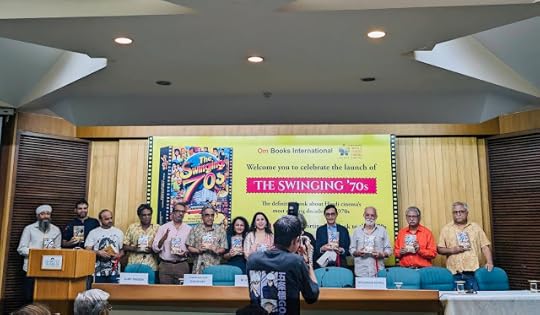Jai Arjun Singh's Blog, page 4
September 16, 2024
Bees saal baad
This blog turned 20 years old a couple of weeks ago. (*Cliche alert* Very strange to think about this - it feels like yesterday that I started writing a few scattered posts with no clear sense that it could lead to anything, or that it would play such a big role in my life as a writer.)
But something else that’s more surprising: since September 2004, not a month has gone by without a post. That’s 240 straight months with some activity, however meagre. (Last month I just maintained the streak, putting up my Economic Times column - the only post - near the end of the month. And now this post has taken the streak to 241.) This despite the fact that in the past decade I have used the blog mainly as an article storehouse and often not visited it for days on end (and my column/review writing reduced greatly during this period, so there often wasn’t much to post anyway). Also, in the last few years there have been many mini-posts/whimsical reflections/updates/event photos which I didn’t put on the blog at all - only on FB or Instagram or on email/WhatsApp groups. But I guess The Streak means I’m still possessive enough about this big green space to keep it somewhat functional. Even if there are only one-and-a-half readers left, and the page rank is now so low that the blog rarely shows up in the first few pages of Google search results... (P.S. here is a post from September 2005, when the blog had just turned one, and I was behaving as if it was the biggest landmark imaginable!)August 29, 2024
Seasons in the sun: how an Anglophone boy failed to engage with (or misheard) Hindi song lyrics
(My latest Economic Times column. It also mentions the bulky new anthology The Swinging Seventies – co-edited by Nirupama Kotru and Shantanu Ray Chaudhuri – which has had many promotional events over the past few months. I have been involved with quite a few of them, mainly in Delhi but also elsewhere. Please look out for the book)
---------------------
Last month, in Bombay, I participated in a few cinema-related panel discussions featuring a number of writers, critics and filmmakers. There was a conversation with director Vishal Bhardwaj and the talented young actress Wamiqa Gabbi about their Khufiya, a spy thriller that in the typical Bhardwaj style also manages to be an unusual love story and a wacky dark comedy. There were also a few discussions around the anthology The Swinging Seventies, a collection of essays about 1970s Hindi cinema.
All this was fun, given the inevitable constraints of a 40-minute session where five or six movie-nerds must condense their thoughts. There was camaraderie, over-the-top fandom, and unexpected links were made. During a tribute to Shyam Benegal, while speaking about a cherished Benegal film Charandas Chor, I took the opportunity to tell fellow panellist Ketan Mehta that his debut feature Bhavani Bhavai was one of my favourite films – artfully melding cinema with folk theatre in much the same way that Charandas Chor did. But there was one session where I felt like an impostor – or at least that I should stay quiet and listen to what other, wiser souls had to say. This was a talk about lyrics in our film songs.
But there was one session where I felt like an impostor – or at least that I should stay quiet and listen to what other, wiser souls had to say. This was a talk about lyrics in our film songs.
Ironically my own piece in the 1970s book had centred on a song – “O Saathi Re” from Muqaddar ka Sikander – which I loved so much as a child that I tried to record myself singing it (before sadly conceding that posterity would be better served by the Kishore Kumar version). But speaking generally, much as I loved film songs while growing up, my engagement with them was more at the level of tune than lyrics. The music would often embed itself into my head even though I hadn’t quite registered the words.
I could, of course, understand an old song with the surface simplicity of, say, “Mera joota hai Japani” or “Nanhe munne bachhe”– and closer to my own time, I loved the lowbrow wordplay of the Tom and Jerry song in Sharaabi (“Khel rahe thay danda gilli / Chooha aage, peechhe billi”), or lyrics that were accessible and integral to a narrative situation, e.g. “Chal mere bhai” from Naseeb. But even today, I can say little of worth about the differences in meter and philosophy in the poetry of, say, Sahir Ludhianvi and Majrooh Sultanpuri. Loving masala Hindi cinema – with its dialogue-baazi and dhishoom-dhishoom – was one thing, but it was quite another to process Hindustani or Urdu phrases of a certain complexity or literariness.
I don’t know if this is a left brain-right brain thing, or something that can be explained by the fact that I grew up in an Anglophone environment, with English as a first language. (Later, in my teens, encountering English lyrics by Dylan or Cohen or even Eminem, I memorised the words of entire songs without even consciously trying.) Or it could be because mainstream Hindi film songs of the 1980s tended to be lyrically formulaic, with endless permutations of “pyaar”, “ikraar”, “deewana” and “parwaana” – and this encouraged laziness as a viewer. As a child I loved romantic songs from films like Love Story, Betaab, Hero, Pyaar Jhukta Nahin and Ek Duuje ke Liye, but then a line like “Yaad aa rahi hai / teri yaad aa rahi hai / yaad aane se, tere jaane se / Jaan jaa rahi hai…” couldn’t be accused of lyrical ambitiousness, whatever else it was. Years later, listening to something like the catchy Govinda-Neelam song “Pehle pehle pyaar ki” from Ilzaam, it was impossible to miss the parts where they went “Pyaar! Pyaar! Pyaar!” in a growing crescendo – but that didn’t require intense concentration on my part.
One offshoot of this was the comedy of misheard lyrics when it came to “deeper” songs. For instance, I spent years wondering why Amol Palekar in “Ek akela iss shahar mein” was always searching for Sabudana, and it came as a relief to learn that other friends had made this mistake too – Gulzar’s “aab-o-daana” being too high-flown for us youngsters. But there is one blooper that’s uniquely my own. It involved a song from the film Sindoor, where Jaya Prada lists the seasons thus: “Patjhad, Saawan, Basant, Bahaar”. The first of those words was so indecipherable for me that I made no effort to understand the meaning of the line – and then, as an insular South Delhi kid, figured that the last two words were “Vasant Vihar”. For a few days I felt a strange pride that a Bombay movie had acknowledged a posh Delhi colony in this timeless way.
Naturally, this was a disclosure I avoided making in the discussion last month, in the presence of Vishal Bhardwaj and many other maestros of song.
------------------------------------
(And a couple of other photos from the sessions, here)
 Khufiya session with Shantanu, Govardhan Gabbi, Wamiqa Gabbi and Vishal Bhardwaj
Khufiya session with Shantanu, Govardhan Gabbi, Wamiqa Gabbi and Vishal Bhardwaj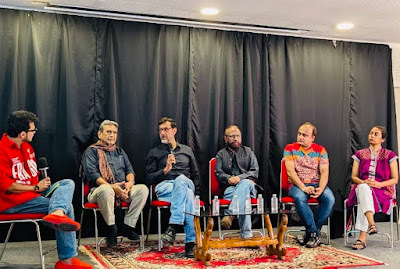 With Ketan Mehta, Rajat Kapoor and others
With Ketan Mehta, Rajat Kapoor and others
July 30, 2024
On the Art-vs-Artist discourse – and why mirrors (including the mirrors provided by “nasty” art) are important
This essay I wrote for an Outlook magazine special is a condensed version of many discussions I have had over the years about the "art-vs-artist" debate. (I find that debate to be annoyingly reductive in most of its current forms – very few conversations/analyses seem to grapple with the possibility that even when someone has done terrible things in one context, they might have other, more exalted, more sensitive places that can produce worthy art. That their work, including their empathetic and ennobling work, can be as much a part of who they are as the things they have done at their very worst. That it is all an organic part of the mess.
Anyway, here is the piece; as always, there is much more rambling to be done along these lines.)
--------------------
As an adolescent movie buff in the early 1990s who became fascinated by old cinema initially through the work of Alfred Hitchcock, I had read enough to know that Hitchcock’s treatment of some of his leading ladies (and his gay or bisexual leading men) could be sadistic. And that Tippi Hedren in particular had been a target of much bullying during the filming of The Birds and Marnie. However, it wasn’t until a decade ago – partly through the Donald Spoto book Spellbound by Beauty – that I learnt of Hedren’s stronger allegations: that Hitchcock made clearly inappropriate demands on her, “expected me to make myself sexually available and accessible”, and played a role in damaging her film career when she didn’t acquiesce.
Some thoughts that flitted through my mind as I processed this: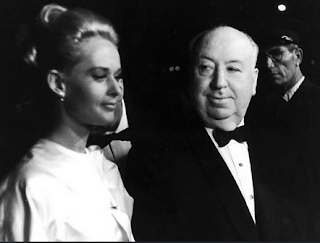 -- If everything Hedren said was true (and there seemed no reason to disbelieve her, especially since she also stressed that the man had other, benevolent sides to his personality) – then, in a fairer world than the one we actually live in, Hitchcock should have been held to account in some clear-cut way, depending on the magnitude of the offence: if not prosecuted by law, then at least prevented from further unmonitored exercising of power and control.
-- If everything Hedren said was true (and there seemed no reason to disbelieve her, especially since she also stressed that the man had other, benevolent sides to his personality) – then, in a fairer world than the one we actually live in, Hitchcock should have been held to account in some clear-cut way, depending on the magnitude of the offence: if not prosecuted by law, then at least prevented from further unmonitored exercising of power and control.
(Of course, this is hypothetical: whether it’s a supposedly backward 1963 or a supposedly enlightened 2024, powerful people with connections routinely get away with crimes. And allegations that by their nature involve private encounters have to be proven, which can provide loopholes to the culpable.)
-- Meanwhile, another scrambled thought: there had been whispers about Hitchcock’s nasty behaviour (did it border on criminal behaviour?) towards other performers like Vera Miles before he worked with Hedren. If he had been brought to book earlier, landmark films like Vertigo and Psycho may not have been made, or not made in the way that they were. This would have very large implications for film history, including the important critical arguments of the early 1960s, which often centred on the value and depth of genre cinema.
It would also have had strong personal implications for me, because much of my life as a film obsessive – and eventually, a writer – dates back to that time, at age 13, when I became deeply moved by Psycho, related to the sadness and darkness in it, and disappeared down a rabbit-hole of cinematic analysis. Without that film to stimulate and console me, it’s likely that my personality and life would have developed in other ways than they did (this could be for bad, or for good, or a mix of both).
And that’s okay – if it helped some meaningful form of justice to be served, c’est la vie.
****
For me, that’s the pragmatic way of looking at these things. What I have *never* felt, though, is that in such cases the director’s films become tainted by association or have to somehow be detached from him, as if their finer, more elevated qualities – which many of us responded to – were independent of the “monster” who helmed them.
Hitchcock apart, I have always been particularly interested in creative people who put a great deal of themselves – their lives, their scars, their best and worst dimensions – into their work. And this may be why I find most iterations of the art-vs-artist debate unsatisfying. The anguished question “Can we separate the art from the artist?” has become a lazy formulation that tends to be answered in one of two ways:
1) I cannot separate the person from his art. Therefore I will not consume any more of his output – for ethical reasons and out of unwillingness to contribute to his income. The art must be rejected as unsavoury;
or, 2) I can separate the art from the artist, and have no issues with continuing to consume it. But this is with the understanding that the art exists in some vacuum, and has little or nothing to do with the artist’s “reality”.
Both positions are fine as statements of intent. But they also carry a buried implication: that when an artist who has done terrible things creates a film (or book, or song) that shows positive human values, it means he was being hypocritical while creating it – concealing his true (bad) self. While there can be some truth to this in specific cases, on the whole I find it a problematic view (to deploy a favourite Woke word). However repulsed we may be by someone’s actions, are we really saying that they couldn’t have more reflective, sensitive sides that they tapped into when doing their best work?
I have been using the pronoun “he”, since male artists are far more often the subjects of such discussion – but the most recent teeth-gnashing centres on the writer Alice Munro and her part-complicity in her daughter Andrea Skinner’s victimisation (by her stepfather, Munro’s husband). And once again the language involved has been the smugly judgemental one that involves labelling someone as a “monster” – as if that was Munro’s sole, defining reality; and the difficulty of squaring this with her much-loved short fiction, known for its wisdom about people and their relationships.
But what does “separating art from artist” even mean, when it comes to creative people who have produced what we think of as personal art – a novelist or painter working alone, or a studio filmmaker picking at and reworking themes within the constraints of his working environment, or a more independent writer-director who has the freedom to make almost anything? 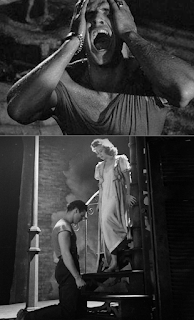 How can you possibly “separate” Hitchcock from (to take just one example) his most critically acclaimed work Vertigo – a film that gets so much of its power from the fact that its depiction of male sexual jealousy and insecurity (and the darker, more possessive aspects of “love”) seems to reflect how Hitchcock himself felt about some of his actresses? How do you separate VS Naipaul from An Area of Darkness? Woody Allen from Annie Hall? Or Marlon Brando – who, by many accounts, participated in the exploitation of Maria Schneider during the Last Tango in Paris shoot – from that animalistic shriek of “Stellaaa!!” in A Streetcar Named Desire: a scream that may come from a little boy terrified of losing his wife, or a patriarchal man who has just attacked that same wife, or both those people cohabiting in the same mind and body.
How can you possibly “separate” Hitchcock from (to take just one example) his most critically acclaimed work Vertigo – a film that gets so much of its power from the fact that its depiction of male sexual jealousy and insecurity (and the darker, more possessive aspects of “love”) seems to reflect how Hitchcock himself felt about some of his actresses? How do you separate VS Naipaul from An Area of Darkness? Woody Allen from Annie Hall? Or Marlon Brando – who, by many accounts, participated in the exploitation of Maria Schneider during the Last Tango in Paris shoot – from that animalistic shriek of “Stellaaa!!” in A Streetcar Named Desire: a scream that may come from a little boy terrified of losing his wife, or a patriarchal man who has just attacked that same wife, or both those people cohabiting in the same mind and body.
And how do you separate Roman Polanski from his work when he embedded his own history, fetishes and traumas into almost everything he did – not just in obviously personal films like the Holocaust-themed The Pianist but even in work adapted from enshrined literary material, like Macbeth (with its gruesome visualisation of the line “Macduff was from his mother’s womb untimely ripped” – just a year after Polanski’s heavily pregnant wife Sharon Tate was murdered).
In Polanski’s case, the facts of criminality are clear and damning: he actually pleaded guilty to unlawful sex with a 13-year-old minor (probably to escape a bigger conviction) and has been a fugitive from the US justice system for over four decades. It is completely reasonable to wish that he had been prosecuted and tucked away in the late 1970s – so what if that halted an illustrious film-making career. But even if you see him mainly and above all else as a predator, erasing his connection with the films he *did* make is a very strange position.
To be clear: apart from the importance of legal reckoning and fair conviction, I understand that someone might be so triggered by the details of the lives of Polanski (or Hitchcock, or anyone else) that they wouldn’t further engage with their work – that is a personal, moral choice, and I have versions of those triggers myself (which aren’t shared by many since they involve non-human-animal welfare more than homosapien-centred issues). What I don’t understand is the removal of Polanski’s name from a 50th anniversary Blu-ray edition of Chinatown (as was done recently), with the virtue-telegraphing pretence that an “evil” man must have no connection with a great film even though so much of what makes it “great” comes directly from him.
******
During a monologue at a recent stand-up performance in Delhi, actor-comedian Vir Das stated that there are two types of people: the ass****s and those who have to deal with the ass****s. The audience laughed and cheered (most of us were probably self-assured that we belonged to the latter category, and could picture any number of our tormentors in the former). “And both those people,” Das continued, “are the same.” This time the chuckles were still there (some of us laugh reflexively whenever any sort of punch-line is delivered), but more muted, as if people didn’t fully comprehend – or like – Das’s point about monsters within and outside us.
In intellectual circles, the line “everyone contains multitudes” is an oft-uttered one (plurality being a liberal commandment) – but looking through my online feeds, and articles written by people whose work I have long admired, I feel very few of us face up to the full, unnerving implications of that idea. Why, for instance, is it so hard to believe that people who have done heinous things in one context are also capable – over a long lifetime – of producing thoughtful, moving art; and doing this *honestly*? 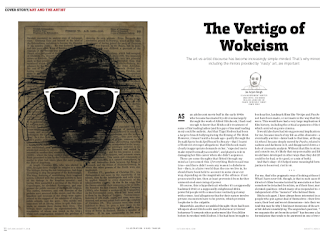 Linked to this aspect of the art-artist debate is something that has been common in recent cultural discourse, perhaps because of how social media encourages swift judgements: a growing intolerance for creative works that are very dark, pessimistic or non-affirmative in their worldview, or prominently use the lenses of unsympathetic characters. More than once, I have heard versions of the question “Why was it *necessary* to make this?” (The recent film Animal has been the subject of many such conversations, and some of the “liberal” bullying has been so shrill that a few perfectly sensible and normally thick-skinned people I know who liked the film – or could at least engage with it – have opted to keep their feelings hidden.) Well, one answer is: it isn’t “necessary” to create any art at all – negative or affirmative. But if you do choose to create, with serious and rigorous world-building, it is fine to tell a bleak, cynical story that doesn’t have comforting takeaways. Such art can make the world a little better not by offering “hope” in some obvious way, but simply by being very well done, presenting a particular way of looking and living, and leaving us with uncomfortable questions that we might or might not be equipped to address.
Linked to this aspect of the art-artist debate is something that has been common in recent cultural discourse, perhaps because of how social media encourages swift judgements: a growing intolerance for creative works that are very dark, pessimistic or non-affirmative in their worldview, or prominently use the lenses of unsympathetic characters. More than once, I have heard versions of the question “Why was it *necessary* to make this?” (The recent film Animal has been the subject of many such conversations, and some of the “liberal” bullying has been so shrill that a few perfectly sensible and normally thick-skinned people I know who liked the film – or could at least engage with it – have opted to keep their feelings hidden.) Well, one answer is: it isn’t “necessary” to create any art at all – negative or affirmative. But if you do choose to create, with serious and rigorous world-building, it is fine to tell a bleak, cynical story that doesn’t have comforting takeaways. Such art can make the world a little better not by offering “hope” in some obvious way, but simply by being very well done, presenting a particular way of looking and living, and leaving us with uncomfortable questions that we might or might not be equipped to address.
Like many others who were seriously invested in books or films from an early age, I grew up believing that one of the important functions of art is to discomfit us and warn us about facile binaries such as “moral” and “monstrous”. But during the recent Munro discourses, I have learnt that it is okay – during an online discussion involving apparently sensitive and intelligent people – for someone to casually label, say, Patricia Highsmith “a horrible person” *and* to posit that this is somewhat understandable given the nastiness or the darkness-bordering-on-nihilism of the stories she wrote.
In creative-writing classes, when the subject of ideology comes up, I occasionally discuss – or conduct a thought experiment around – the novel The Glass Pearls, by the great screenwriter Emeric Pressburger. Here was a Jewish man who had to flee Germany in the 1930s, whose mother died in a concentration camp, who lived in fear of Nazi persecution… and who also wrote this thriller about a Nazi in hiding in 1960s England, where the narrative’s impact hinges on us being able to feel for the protagonist – not to think that Karl Braun is a “good” person who should escape justice, but to see that he is a multi-dimensional human being with qualities all of us can relate to. We feel his genuine sense of paranoia and persecution, his grief for a wife and child who died, his boy-like excitement at a new romantic prospect. And these are all *honest* emotions. But many of the people who hold forth these days about art and artists, or draw a clear-cut line between “toxic” and “progressive” films, wouldn’t know how to deal with Pressburger’s book – or thousands of others like it.  One of the more sensible things I have read in Munro-related chatter is from the writer Brandon Taylor, who points out that what most people love about Munro’s fiction is “the way she reveals how, at bottom, we are capable of true ugliness and viciousness” – and yet, despite this, the same readers are confused when they learn of “the common smallness” of someone they admired. “That, to me, betrays a lack of understanding of human nature, particularly the one advanced by Munro’s work,” Taylor says, and I agree. More pertinent than that hoary “art-artist” question is this: how has it become so easy to ignore the mirror, to outrage constantly over instances of misbehaviour that most of us would be capable of given the right (or wrong) circumstances – and to fail to recognise the things that good art (including the art made by people who do bad things) can tell us about ourselves?
One of the more sensible things I have read in Munro-related chatter is from the writer Brandon Taylor, who points out that what most people love about Munro’s fiction is “the way she reveals how, at bottom, we are capable of true ugliness and viciousness” – and yet, despite this, the same readers are confused when they learn of “the common smallness” of someone they admired. “That, to me, betrays a lack of understanding of human nature, particularly the one advanced by Munro’s work,” Taylor says, and I agree. More pertinent than that hoary “art-artist” question is this: how has it become so easy to ignore the mirror, to outrage constantly over instances of misbehaviour that most of us would be capable of given the right (or wrong) circumstances – and to fail to recognise the things that good art (including the art made by people who do bad things) can tell us about ourselves?
-----------------
(Related posts: glorification vs depiction, etc; The Glass Pearls)
July 23, 2024
Dog time: on Snowy/Whitey, an old lady of Saket (2007-24)
For most of her long life, “Snowy” and I hadn’t interacted at all; it’s only yesterday that I learnt her many names. And yet she was central to my memories of this part of Saket – because in 2007, just after we moved to D-block, she was the first puppy I noticed. I wasn’t seriously interested yet in street dogs (this was a year before we adopted Foxie and my life took a new, maternal turn), but we indulged this pup when we saw her during evening walks – she was being looked after by a guard, was small and very alert and friendly. I seem to remember the guard noting our fondness and asking if we would like to take her home, but I’m not sure. Anyway, that’s a parallel-universe tale.
In this universe she ended up spending her life along a 150-metre span of colony road, near the 2-3 houses where people were fond of her. Whenever I saw her in the distance, I would think “She must be 10/12/15 years old now, because that’s when we moved here.” And I would think about some of the signposts of my own life – good and bad – in these last two decades.
The first video above, from three years ago, is the only video (or photo) I ever took of her. It was January, someone had put a jacket on her – but then it rained and as so often happens no one was around to take the jacket off and prevent it from getting badly soaked and affecting her health. So I approached her, taking a video for the animal groups as a caution, and got it off. As you can see, she was nervous and didn’t remember me (in dog years it must have been 7-8 decades since her childhood interactions with me).
Yesterday morning a neighbour who didn’t have a car handy called in distress to inform me of Snowy’s death, and I’m glad I got the chance to take her on her final journey – it was an important journey for me too. The pics below are of the last rites – as you can see, there was a solemn-looking abandoned pitbull at the shelter who hung around watching…


(Also see this post about our Kaali - one of the most important dogs in my life - who died in February this year)
July 19, 2024
A new book about Telugu screen deities, and how they come into existence
(Wrote this short review for India Today)
---------------
It’s rare to find good personal writing in cinema books – the sort that can deal intelligently and capaciously with a chosen topic while also bringing the author’s life and concerns into the frame. Mukesh Manjunath’s The Age of Heroes – about the cult of “heroes” in Telugu cinema, and how the relationship between superstar/deity and adoring fan plays out across such fault-lines as caste, class and gender – is a fine exception. Consider a moving passage where he mentions his grandmother’s obsession with the superstar NT Rama Rao, whom she never got a chance to see in person: “During her youth all she wanted was someone like NTR in her life […] That was the first time she even knew she could fantasise about another man.” The story culminates in the author realising why he was always her favourite grandchild – because he was born on NTR’s birthday and she saw him as an answer to her prayers for a glimpse of her idol.  Many people – especially those who don’t get the appeal of popular cinema and popular movie stars – will scoff at such a story, or be offended that a cherished real-life relationship should be forged under the shadow of obsessive fandom. But these are very real, and very nourishing, aspects of the cinema-viewer bond – they have been since the beginnings of the medium – and South India has had many divinities who began as screen icons and later moved on to political careers; in the process coming to represent many important things to their followers. Manjunath examines this complex story as it has unfolded over the past seven decades.
Many people – especially those who don’t get the appeal of popular cinema and popular movie stars – will scoff at such a story, or be offended that a cherished real-life relationship should be forged under the shadow of obsessive fandom. But these are very real, and very nourishing, aspects of the cinema-viewer bond – they have been since the beginnings of the medium – and South India has had many divinities who began as screen icons and later moved on to political careers; in the process coming to represent many important things to their followers. Manjunath examines this complex story as it has unfolded over the past seven decades.
He discusses the lingual differences and post-Independence histories of the Telugu-speaking regions, starting with the formation of Andhra Pradesh in the 1950s, and the effect of folk-tales on popular cinema. He speaks to fans to try and understand what they mean when they say mystical-sounding things like “there is an aura around Chiranjeevi”. There is an illuminating chapter about the “female hero” Vijayashanthi, who blazed a trail across the Telugu film universe in the 1980s and 1990s. And there is a fascinating section about Erra or Red Cinema, and its founding deity R Narayana Murthy – films with protagonists from historically oppressed castes, very conscious of their oppression (as opposed to the more broadly defined vigilante figures). In this chapter he discusses the much-criticised film Arjun Reddy in terms that may not be immediately clear to a non-Telugu viewer – the star Vijay Deverakonda’s brandishing of the Telengana accent “like a sword”, bringing coolness and legitimacy to a dialect that was once seen as crude or impure. This is notable, being a reminder that a “problematic” character who can be seen as an oppressor or a bully in one context (as Arjun Reddy might be in terms of his treatment of women) can on another level be a subaltern hero for a marginalised group.
Early on, Manjunath clarifies that this book isn’t just for those who know Telugu cinema and culture well. This reviewer was glad for his own familiarity with some films discussed here – such as the brilliant 1951 fantasy Pathala Bhairavi, or the mythological Daana Veera Soora Karna, in which NTR played Karna, Duryodhana and Krishna – but also learnt much about the subtexts surrounding those films, and what they represented to the local culture, e.g. how a story’s villain (SV Ranga Rao as the wicked sorcerer in Pathala Bhairavi) is shown to be an outsider through his distorted pronunciations, or how a Rajasthani setting is reshaped and appropriated for Telugu viewers.
The Age of Heroes was completed in 2019, which makes the contemporary references feel dated (RRR is referred to as an upcoming film), and the editing is occasionally sloppy. But this is offset by the fact that the writing is funny in a wry, conversational way – it feels like the author is chattering directly to you. This warm and informative book can open new windows for film buffs hoping to broaden their understanding of the many worlds that exist under the umbrella term “Indian cinema”.
July 8, 2024
The old man in the studio: Guru Dutt Dark, and Guru Dutt Light (or Lite)
(As Guru Dutt’s centenary year begins, I wrote this personal tribute for Money Control)
--------------------------
I remember being stunned when I first learnt that Guru Dutt was only thirty-nine when he died.
Not because it was such a young age, or because of the question of how and why he had gone so soon – all that was part of it, yes, but there was a deeper reason. It was because my first (and for many years, my sole) viewing of Guru Dutt on the screen was as an old, old man with his features buried beneath a thick white beard. That was the only image I carried in my head for a long time.  This was via a Doordarshan telecast of Kaagaz ke Phool sometime in the mid-1980s – a film I caught only the beginning and the end of.
This was via a Doordarshan telecast of Kaagaz ke Phool sometime in the mid-1980s – a film I caught only the beginning and the end of.
Suresh, a once-famous movie director, now old and destitute, is revisiting the studio that was the site of his greatest triumphs. He wanders slowly around the deserted space, ascends a stairway as “Dekhi Zamaane ki Yaari” plays on the soundtrack. Suresh is played by Guru Dutt, only in his early thirties at the time, but to a nine-year-old’s eyes the man on the screen looks ancient. (It was fairly impressive old-age makeup for a period when Hindi films tended to depict car-accident survivors with a careless brush of paint across their faces.)
An uncle who is watching TV with us makes an oblique remark about the film being Guru Dutt’s “real story”, discreetly adding something I couldn’t decipher at the time, but which probably implied that he was in love with Waheeda Rehman and had died of a broken heart. These remarks seemed to add much mystery to this figure.
I wasn’t curious enough to watch the film, and so I missed the entire mid-section where Guru Dutt looks much younger, even dashing. I remember the ending, though, because the scene where the old man is discovered dead in his chair left a big impact. My uncle’s words, blurring the line between fiction and reality, had already given the whole thing the force of a documentary, or a “found footage” film, and part of my child-mind was convinced I had seen the real Guru Dutt, tragic actor-director-lover, dead on the screen. 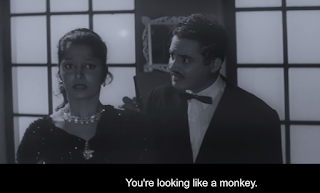 For years after this, I never got to see Guru Dutt in a film – maybe just an indeterminate magazine photo here or there – so he remained very old and gloomy in my mind. This changed when, as a youngster educating myself in classic cinema, I watched his major films in their entirety, got to see him even in his boyish, bantering, clean-shaven avatar in the first half of Sahib Bibi aur Ghulam, or in Chaudhvin ka Chand. But that initial impression never fully went away. After all, even as literate film students, what we are always told about Guru Dutt the auteur is that Pyaasa and Kaagaz ke Phool – two dark, solemn, sometimes oppressive works – were his defining films.
For years after this, I never got to see Guru Dutt in a film – maybe just an indeterminate magazine photo here or there – so he remained very old and gloomy in my mind. This changed when, as a youngster educating myself in classic cinema, I watched his major films in their entirety, got to see him even in his boyish, bantering, clean-shaven avatar in the first half of Sahib Bibi aur Ghulam, or in Chaudhvin ka Chand. But that initial impression never fully went away. After all, even as literate film students, what we are always told about Guru Dutt the auteur is that Pyaasa and Kaagaz ke Phool – two dark, solemn, sometimes oppressive works – were his defining films.
There is much truth to this, of course: those are towering films, the ones he will most be remembered for as a personal filmmaker working within a commercial, sometimes heartless industry and often using his medium to comment on the plight of the artist. And I say this as someone who once had major reservations about Pyaasa, and came to fully appreciate it only in recent years.
Some of this may have to do with the fact that for years I had access to a mediocre print which couldn’t do justice to Pyaasa’s visual beauty, jointly conceptualised by Guru Dutt and his great cinematographer VK Murthy. But it was also because the protagonist Vijay was so self-righteous and entitled (all of which remains true in a broader sense for so many male leads through Hindi-cinema history), and I thought Guru Dutt underwhelming *as an actor*. I had impassioned exchanges with others who felt similarly, as well as with those who liked Pyaasa but felt it was less than the sum of its parts (some of those brilliant parts being Waheeda Rehman, SD Burman and Sahir Ludhianvi, Geeta Dutt and Mohammed Rafi, and of course VK Murthy).
Re-watching Pyaasa a few months ago, I loved it almost unconditionally. I still feel Vijay is a whiner who over-fetishizes his own sensitivity, thinks the world owes him appreciation, and is so lost in his own world that he can’t even check on his mother to see how she is doing. (A case can be made for Johnny Walker’s Abdul as being the real artist of the story, using hair oil and humour as his creative tools!) But the film itself has a depth and soulfulness that its protagonist sometimes lacks, and this is before one even looks at its extraordinary visual and musical qualities. 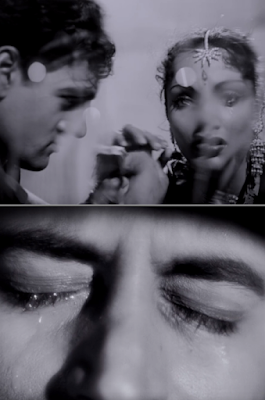 As anyone who has taught or studied Hindi cinema knows, both Pyaasa and Kaagaz ke Phool have classic moments that lends themselves to endless analyses. If Mukesh was famously Raj Kapoor’s voice, VK Murthy was Guru Dutt’s piercing eye in these films, and this is literalised in Pyaasa in the audacious shot just before the song “Jinhe Naaz Hai Hind Par” begins: Vijay watching as a young woman in a brothel, a mother wanting to tend to her infant child, is bullied into performing for her drunk clients. As Vijay weeps silently at the sight, the faces he is looking at become distorted by “tears”, to show his perspective.
As anyone who has taught or studied Hindi cinema knows, both Pyaasa and Kaagaz ke Phool have classic moments that lends themselves to endless analyses. If Mukesh was famously Raj Kapoor’s voice, VK Murthy was Guru Dutt’s piercing eye in these films, and this is literalised in Pyaasa in the audacious shot just before the song “Jinhe Naaz Hai Hind Par” begins: Vijay watching as a young woman in a brothel, a mother wanting to tend to her infant child, is bullied into performing for her drunk clients. As Vijay weeps silently at the sight, the faces he is looking at become distorted by “tears”, to show his perspective.
Then there is that legendary moment during “Waqt ne kiya” in Kaagaz ke Phool, Suresh and his muse Shanti in the film studio having just bonded with each other. A beam of light (captured by Murthy through the artful placement of two mirrors) falls between them. And then, while they stand physically apart, knowing they can’t be together, their souls move towards each other and unite in the light; in an ethereal, unreal space where anything might be possible. Elsewhere in the film, the lyrics of a song mention “one” and “zero” being separated after they came together to form something much greater (ten) than either of them – an analogy for the Shanti-Suresh relationship, completing each other artistically and emotionally. In the “Waqt ne kiya” scene, the camera finds another way of expressing this.
*****
Such moments – timeless in their poignancy, testament to a mind that thought in the cinematic language of light and shadow – mark Guru Dutt’s filmmaking career. And yet, to grasp the entirety of that career, it is important to look beyond the veneer of darkness and see the breezier things he was capable of as director and actor.
To re-watch Aar Paar (1954) and Mr and Mrs 55 (1955), for instance, is to marvel that these films were made by the same man who made Pyaasa and Kaagaz ke Phool – and yet, when you look closely enough the connection is easy to make. The dominant tone of these earlier works might be playfulness, but some of the director’s concerns and strengths are right there: the interest in film form, the thoughtful and inventive composition of major sequences. In Mr and Mrs 55, there is even a key motif which would later be seen in his two iconic tragedies – the theme of the artist in the gutter, impoverished and trampled on – but here it is treated with humour. Dutt plays an unemployed cartoonist named Preetam, heavily dependent for money on a reporter friend, until he meets the beautiful heiress Anita (Madhubala) and is hired to be a temporary husband – but meanwhile he and Anita are falling in and out of love. 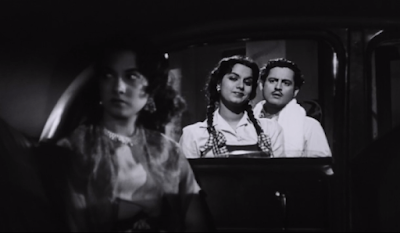 Once a non-fan of Guru Dutt the actor, I was converted by his roles in both Mr and Mrs 55 and Aar Paar. In the latter, playing the dashing young taxi driver Kalu Birju, he shows a sly sense of humour that makes him a worthy kindred spirit to Johnny Walker and the teenage Jagdeep. In the same year that his friend Dev Anand – a more suave “hero” figure – played a cab driver in another film (Taxi Driver), Guru Dutt manages to be just as charismatic, even stylish, in his own way – whether he is mock-punching at Nikki (Shyama) when he comes to her father’s workshop late at night (“Mard ka bacha hoon – sar utha ke chalta hoon”) or teaching her how to put her lips together and whistle (much like Lauren Bacall did with Humphrey Bogart), or saying a sardonic “Thank you very much, kindly” in English. He is incredibly likable in the scene where he visits the jailer and asks for a character “certificate” so Nikki’s family will know he wasn’t jailed for a major offence.
Once a non-fan of Guru Dutt the actor, I was converted by his roles in both Mr and Mrs 55 and Aar Paar. In the latter, playing the dashing young taxi driver Kalu Birju, he shows a sly sense of humour that makes him a worthy kindred spirit to Johnny Walker and the teenage Jagdeep. In the same year that his friend Dev Anand – a more suave “hero” figure – played a cab driver in another film (Taxi Driver), Guru Dutt manages to be just as charismatic, even stylish, in his own way – whether he is mock-punching at Nikki (Shyama) when he comes to her father’s workshop late at night (“Mard ka bacha hoon – sar utha ke chalta hoon”) or teaching her how to put her lips together and whistle (much like Lauren Bacall did with Humphrey Bogart), or saying a sardonic “Thank you very much, kindly” in English. He is incredibly likable in the scene where he visits the jailer and asks for a character “certificate” so Nikki’s family will know he wasn’t jailed for a major offence.
While the film is passable as a thriller, and for its street-level views of Bombay as a city of crime, it is obvious that Guru Dutt had a special knack for staging song sequences. This was clear even in his earliest films as director, Baazi and Jaal. Look at the brilliant “Yeh Raat, Yeh Chandni” sequence in Jaal, where a rakish Dev Anand seduces Geeta Bali – with its sense that the young woman is being drawn out of her safe space not just by the music and the words but by the camera itself; and the dangerous, noir-ish imagery of trees silhouetted against the night sky with the moon shining through them (“Pedon ki shaakhon pe soyi soyi chandni”). Here is the use of a device – a Hindi-movie song – that no Hollywood noir would employ, yet it works so well.
In Aar Paar, I particularly love the conceptualisation of the “Mohabbat kar lo, ji bhar lo” song, in which Kalu Birju’s cynical-sounding view of love finds a counterpoint in the views expressed by others around him. In its depiction of the various possibilities of love – as deceit, farce, but also something one can’t do without – this sequence is a dynamic bit of multi-perspective storytelling, beautifully framed and composed, much more interesting done than a similar scene in the much later Trishul, where Amitabh Bachchan, Hema Malini and Shashi Kapoor sing of the pros and cons of “mohabbat”.
*****
So how does one account for the dichotomy between the tragic Guru Dutt of Pyaasa and the genial leading man of Aar Paar, who was so comfortable bantering with comic sidekicks, or playing screwball comedy? The only answer is that you have to watch the films themselves, to see how a theme that is given solemn treatment in one context can be dealt with lightly in another space, without compromising the director’s personal vision. After that, it’s up to you as viewer to decide if you prefer the grand but occasionally pedantic tone of a Kaagaz ke Phool or the breeziness of a Mr and Mrs 55, or if you can see them as being all of a piece. Where different cinematic idioms can be used for the meeting of hearts and minds. (To offset that hyper-dramatic shaft-of-light moment in “Waqt ne kiya”, there is a sweeter, more literal shot in Aar Paar’s “Sun sun sun” where Guru Dutt and Shyama, standing on opposite ends of a pillar, meet each other on the other side, outside our view.)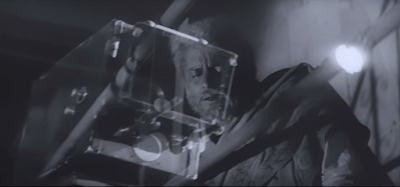 There is often a large gap between our childhood memory of a film and the experience of watching it again as an adult – but for me, an exception to this rule remains that opening fragment of Kaagaz ke Phool. The scene – the forgotten old director drifting around the studio – was indelible in my mind for decades, and when I watched the film as an adult, it turned out to be exactly as I remembered it. Which rarely happens. Maybe this adds to the case for Guru Dutt as a great director – so much in control of his frames and his personal vision that even a child’s mind had no option but to deferentially remember a scene as it had unfolded. And maybe, in some parallel universe, the man who died so young – and burnt so bright – really is wandering around a studio where he gets to realise his dream projects, and finds a measure of peace in doing so.
There is often a large gap between our childhood memory of a film and the experience of watching it again as an adult – but for me, an exception to this rule remains that opening fragment of Kaagaz ke Phool. The scene – the forgotten old director drifting around the studio – was indelible in my mind for decades, and when I watched the film as an adult, it turned out to be exactly as I remembered it. Which rarely happens. Maybe this adds to the case for Guru Dutt as a great director – so much in control of his frames and his personal vision that even a child’s mind had no option but to deferentially remember a scene as it had unfolded. And maybe, in some parallel universe, the man who died so young – and burnt so bright – really is wandering around a studio where he gets to realise his dream projects, and finds a measure of peace in doing so.
June 22, 2024
Tan tana tan: How I learnt to stop gritting my teeth and love a Judwaa song
(Wrote a version of this for my Economic Times column)
-----------------
Earworms slither in mysterious ways. During a recent cine-club discussion that could be described as classy (if not outright highbrow), my friend Tipu – a man of such learning and refinement that he would bunk school to watch Tarkovsky films – shared a five-second video. It was part of the “Tan Tana Tan” song from David Dhawan’s 1997 Judwaa (a film Tarkovsky never lived to see, though I like to imagine he shook a leg to Disco Dancer tunes in the early 1980s like all other Russians). The clip in question had the “Chalti hai kya nau se baarah” line, and was probably in response to someone on the group mentioning show timings of yore. 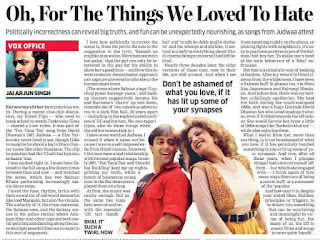 And I was sucked right in. I must have listened to the entire song a few dozen times between then and now – and just as importantly, watched the scene which has two Salman Khans performing a series of increasingly manic dance steps in accompaniment with (mostly) Karisma Kapoor and Rambha. I loved the tune, the rhythm, the lyrics with their evocation of distant old-world memories like iced Mangola, but also the mad visuals: the audacity of it, the crass maleness, the Salman-ness, and the fantasy scenes in the police station where Anupam Kher and other cops are both moral-policing and dancing along rambunctiously (because multiple possibilities can co-exist in this sort of sequence).
And I was sucked right in. I must have listened to the entire song a few dozen times between then and now – and just as importantly, watched the scene which has two Salman Khans performing a series of increasingly manic dance steps in accompaniment with (mostly) Karisma Kapoor and Rambha. I loved the tune, the rhythm, the lyrics with their evocation of distant old-world memories like iced Mangola, but also the mad visuals: the audacity of it, the crass maleness, the Salman-ness, and the fantasy scenes in the police station where Anupam Kher and other cops are both moral-policing and dancing along rambunctiously (because multiple possibilities can co-exist in this sort of sequence).
I also love how politically incorrect the scene is, from the pelvic thrusts to the suggestion, in the lyric “Samajh na mujhko aisa waisa / Mere batuwe mein hai paisa”, that the girl can only be interested in the guy for his money and his ability to show her a good time – and how this lowest-common-denominator approach, which might be triggering to some viewers, can capture broad emotional truths about the human experience. (The scene where Salman sings “Gupchup pyaar karenge yaara”, and backup dancers suggestively bounce his and Karisma’s “chairs” up and down, reminds me of two of my amorous adventures in a dark film hall, twenty years apart – including one in the sophisticated confines of an India International Centre auditorium mostly populated by snoring octogenarians. We non-tapori types also do these things when the old hormones kick in.)
Now, some back-story: I have never watched Judwaa. I missed it when it came out because I was on a self-imposed exile from Hindi cinema at the time (though, as it happened, I let some friends take me for a hall viewing of another Salman film of the period, Pyaar Kiya toh Darna Kya). However, I did once have a bad relationship with Judwaa’s most popular songs – long before I knew which film they were from. Sometime in early 1997, “Tan Tana Tan” and “Oonchi hai Building” became much more traumatising earworms, keeping me up nights.
For one reason or another, 1996-97 was a period of very scant film-viewing for me, with weeks often passing without watching anything except for music videos and Tendulkar innings – but in the midst of that barren time I was awake, gritting my teeth, while a bunch of boisterous young men in the flat downstairs played those songs on loop. At first the music was catchy enough, but as the same two numbers wore on and on, with the repeated “lift teri bandh hai” and “mudh ke dekh mujhe doobara” and the whoops and shrieks, it seemed to confirm everything about Hindi cinema being a universe I had left behind. 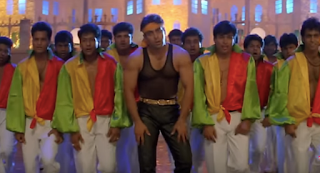 Nearly three decades later, some members of that rowdy family still move in and out of the downstairs flat – which has been the subject of property disputes and bad blood – and when I see the older versions of those men, now in their fifties, speaking rudely on the phone or even smacking a driver who has moved too close to their parking space, it’s easy to peg them as stereotypes of the Salman/bad-boy fan. To shake one’s head at the toxic behaviour of a “Bhai” enthusiast.
Nearly three decades later, some members of that rowdy family still move in and out of the downstairs flat – which has been the subject of property disputes and bad blood – and when I see the older versions of those men, now in their fifties, speaking rudely on the phone or even smacking a driver who has moved too close to their parking space, it’s easy to peg them as stereotypes of the Salman/bad-boy fan. To shake one’s head at the toxic behaviour of a “Bhai” enthusiast.
But that is a simplistic way of looking at fandom, and there doesn’t have to be a personality match of that sort. After my return to Hindi cinema from the wilderness, I have been a Salman fan myself in phases, via such films as Jaanemann or Bajrangi Bhaijaan or Mujhse Shaadi Karogi. And before that, there was my mother, unfailingly egalitarian. She kept the faith during that much-maligned decade when I wasn’t watching Hindi films, and was a huge Govinda-David Dhawan buff in particular who loved madcap humour, even if it tilted towards the off-colour: she would furrow her brow a little at 1990s songs like “Sarkailo Khatiya” while also enjoying them. 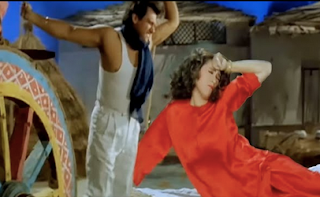 What I learnt from her, more than anything else, is to not be ashamed of what you love, if it has genuinely touched something in you or lit up some of your indecipherable synapses. And now, after all these years, when I get little glimpses of the things I had once cut myself off from – but which she engaged with – I think again of how many different ways there are of being a movie-buff, or a consumer of the “popular”. And how easy it is, despite your stated likes, dislikes, principles or triggers, to be drawn back into something that can be nourishing and meaningful by virtue of being fun. For many of us, the lift to massy films and massy songs is never quite “bandh”.
What I learnt from her, more than anything else, is to not be ashamed of what you love, if it has genuinely touched something in you or lit up some of your indecipherable synapses. And now, after all these years, when I get little glimpses of the things I had once cut myself off from – but which she engaged with – I think again of how many different ways there are of being a movie-buff, or a consumer of the “popular”. And how easy it is, despite your stated likes, dislikes, principles or triggers, to be drawn back into something that can be nourishing and meaningful by virtue of being fun. For many of us, the lift to massy films and massy songs is never quite “bandh”.
May 11, 2024
About a new anthology of Indian crime writing (from pulp to self-reflexive, and everything in between)
(wrote this long review for Scroll)
----------------
The two-volume Hachette Book of Indian Detective Fiction – edited by Tarun K Saint – has a problem that is a mostly useful one – a problem of plenty. This is something you might expect from a collection of 36 stories (more than two-thirds of them written especially for these books) that fall under the broad rubric “Detective Fiction”, with the many styles and sub-genres implied by that descriptor. In his Introduction, Saint reminds us of the vastness of crime writing – from its tentative roots to the current day, where it often merges with other genres such as fantasy or historical fiction; from thrill-a-minute mysteries (often condescendingly dismissed as “pulp”) to narratives that have deeper sociological underpinnings, or aim for greater realism in their world-building. 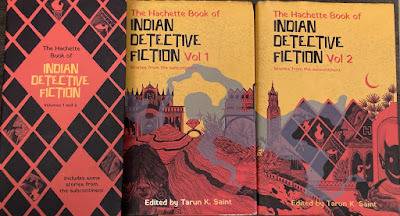 Most of those modes are well-represented here. Volume 1, for instance, begins with cosy, old-style mysteries featuring two of the most popular detectives in Bengali literature, Saradindu Bandyopadhyay’s Byomkesh (“The Rhythm of the Riddles”) and Satyajit Ray’s Feluda (“The Locked Chest”) – this is the sort of writing that is endlessly comforting for classic-mystery fans, even when familiarity takes away some of the suspense. The more contemporary stories that come immediately after these – including a poignant one (“Sepal”) by the Tamil writer Ambai, which is as much about love and possessiveness as about crime – are also in the traditional investigative mode. But by the second half of this book, we have reached edgier, more experimental terrain. Now there are philosophical, self-reflexive pieces by Tanuj Solanki (“The Desire of the Detective”) and Anil Menon (“A Death Considered”), which examine the nuts and bolts of suspense writing, mulling on the nature of the narrative-construction required by the genre – as well as the nature of viewer participation, or our willingness to be deceived.
Most of those modes are well-represented here. Volume 1, for instance, begins with cosy, old-style mysteries featuring two of the most popular detectives in Bengali literature, Saradindu Bandyopadhyay’s Byomkesh (“The Rhythm of the Riddles”) and Satyajit Ray’s Feluda (“The Locked Chest”) – this is the sort of writing that is endlessly comforting for classic-mystery fans, even when familiarity takes away some of the suspense. The more contemporary stories that come immediately after these – including a poignant one (“Sepal”) by the Tamil writer Ambai, which is as much about love and possessiveness as about crime – are also in the traditional investigative mode. But by the second half of this book, we have reached edgier, more experimental terrain. Now there are philosophical, self-reflexive pieces by Tanuj Solanki (“The Desire of the Detective”) and Anil Menon (“A Death Considered”), which examine the nuts and bolts of suspense writing, mulling on the nature of the narrative-construction required by the genre – as well as the nature of viewer participation, or our willingness to be deceived.
“In a detective novel, everything and everyone is unreliable. Everybody lies. Every character is an ‘unreliable narrator’, as we writers say in our lingo. That is also exactly how it is in life.”
As it happens, another of the meta stories here – reflecting on the genre, subverting our ideas about it – comes from a much earlier time, and an old master: Rabindranath Tagore's “Detective” (translated by Shampa Roy) is drolly funny, especially when a police-department detective named Mahimchandra bemoans the lack of enterprise and cunning in Indian criminals, and says it would be much more stimulating to work as a crime-solver in Europe. (It’s another matter, of course, that this detective may not be as alert or self-possessed as he likes to think!)
The setting can be futuristic too, or entirely of the mind – there are a few encounters here with sci-fi and speculative fiction. Navin Weeraratne’s “DeathGPT” and Sumit Bardhan’s “Death of an Actress” both – in different ways but with comparable resolutions – involve the death or disappearance of a performer, a detective’s efforts to connect the dots, and end with the questioning of what we call reality. Kiran Manral’s “Witch Hunting” is also about the unreliability of perceptions, or self-perceptions – and not just because it is about a future-era detective time-traveling back to 1984 Bombay (and being startled to discover that no one is to be seen on the road in this most populous of cities). Another highlight, Kehkashan Khalid’s “Andheri Nagri”, centres on an enigmatic woman who could be a serial killer moving through time and space, but could also be viewed as someone who is simply “fixing the world”.
The funniest of these excursions into fantasy, Saad Z Hossain’s “The Detective of Black Korail”, is a witty tale set in a magical space within Dhaka’s Korail slum, where a sheriff named Mok – now living a ghostly life under the patronage of a “witch”– investigates the gory murder of a chauffeur. Much of the pleasure of reading this piece comes from the matter-of-fact interactions between humans and supernatural creatures – hanging over these interactions are also questions of othering and privilege, though Hossain never underlines this.
Incidentally, it gave me a little kick to see that these stories – experimental, cerebral or both – are placed very close to an unabashedly pulpy tale, Tamilvanan’s 1967 “Tokyo Rose” (translated by Pritham K Chakravarthy and published in the delightful Blaft Anthology of Pulp Fiction a few years ago). Here, Shankarlal, immodestly described as “the king of detectives”, is in Tokyo with his wife Indra when things around them – from soap to a cup of tea – suddenly start turning blue (causing nervous Japanese to wonder if this is the effect of a new atom bomb). Shankarlal solves this incidental mystery fast enough, but then gets drawn into an exciting case involving a kidnapping. This story is, to use a cinematic analogy, like an old Rajinikanth film placed amidst a list of modern, detail-heavy OTT shows, and I was very pleased by its inclusion.
****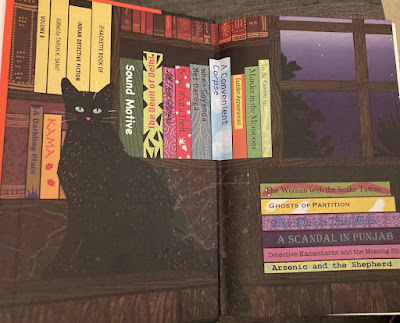 Volume 2 begins with Vikram Chandra’s masterful “Kama” – close to novella-length and first published in the 1997 Love and Longing in Bombay – which is almost worth the price of admission by itself. It has the cop protagonist Sartaj Singh (who later got a more expanded fictional life in Chandra’s epic novel Sacred Games and the web series adapted from it) trying to figure out the family dynamics of a middle-aged murder victim who has left behind a wife and a teenage son. But the story is as much about the workings of intimacy in its many forms, about lost love (Sartaj and his estranged wife Megha are on the verge of divorce), about the things that people might do to bring newness into their relationships, and even about how one’s parents – living in a less demonstrative age – may have expressed their affection.
Volume 2 begins with Vikram Chandra’s masterful “Kama” – close to novella-length and first published in the 1997 Love and Longing in Bombay – which is almost worth the price of admission by itself. It has the cop protagonist Sartaj Singh (who later got a more expanded fictional life in Chandra’s epic novel Sacred Games and the web series adapted from it) trying to figure out the family dynamics of a middle-aged murder victim who has left behind a wife and a teenage son. But the story is as much about the workings of intimacy in its many forms, about lost love (Sartaj and his estranged wife Megha are on the verge of divorce), about the things that people might do to bring newness into their relationships, and even about how one’s parents – living in a less demonstrative age – may have expressed their affection.
There are other pieces I enjoyed because they involve not a flurry of legwork and clue-scouting, but laidback conversations where different possibilities are turned over. In Rajarshi Das Bhowmik’s “Detective Kanaicharan and the Missing Ship” (translated from the Bengali by Arunava Sinha), a senior inspector – temporarily off duty and looking for ways to occupy his mind – becomes interested in a century-old case involving a ship that apparently vanished in the Bay of Bengal en route to the Andamans with a political prisoner. With little by way of immediate “action” in a story like this (apart from consulting the archives for such banal things as weather conditions in 1913), it is the talk between Inspector Kanaicharan and his subordinate, the gradual unveiling of historical as well as contemporary information, that holds one’s attention – I was reminded, pleasantly, of other stories involving lengthy conjectures (rather than active sleuthing), such as Josephine Tey’s The Daughter of Time and Agatha Christie’s Murder in Retrospect.
Another such story, Ajay Chowdhury’s “The Woman with the Snake Tattoo”, concerns the murder of a jeweller in his office shortly after a woman comes to meet him for an early appointment – this is a more conventionally structured tale about a fresh crime, but the heart of it occurs in a discussion between the detective and his fiancée as they discuss the case, finally arriving at an answer. Madhulika Liddle’s “A Convenient Corpse” – a new story featuring her popular 17th century detective Muzaffar Jung – is similar in that it involves conversations between sleuth and spouse, suggesting that detective work doesn’t have to be a genius’s solitary pursuit, it can be a social or collaborative undertaking too.
Liddle’s story is one of a few historical mysteries in the second book. Another such – also involving a collaborative endeavour, geared at “solving” a society through an examination of its crime – is Anuradha Kumar’s “Sudden Appearances”, a moving tale that playfully uses real-life figures like Emilie Moreau and Rudyard Kipling in a story that appears to have a supernatural element (an appearance by the supposed ghost of a woman who may have died or been killed recently) but also moves past this playfulness to become a serious examination of a social ill of the period.
One truly singular tale in this set – which seems to move beyond most expectations of this genre – is Avtar Singh’s haunting “A Scandal in Punjab”, the last of the 36 pieces. The crime here – the apparent purloining of a watch owned by a brown sahib named Bik during a 1947 pig hunt – is on the face of it less serious than most of the other crimes in the book; but this is also a metaphysical mystery where the timepiece, and those who either own or admire it, are caught in a fierce dance of class, power, manners and one-upmanship in a country heaving towards independence, with all the terrors and excitement involved in this great shift. In its tangential way, then, this is as striking a 1947 story as many others you might read (including a couple in this book, such as Vaseem Khan’s “Ghosts of Partition”).
The timepiece motif in Singh’s story also reminded me Giti Chandra’s “A Darkling Plain” (in Volume 1), about a policewoman investigating the murder of a young student in a posh Delhi University college: though that plot summary doesn’t do justice to the story, which grows in the telling – moving between two separate voices – until it reveals itself to be a comment on caste identity, and identity more generally, a tale where ID cards and ticking clocks become both red herrings and symbols.
****
In critics’ discussions, one truism that often comes up is that in a good creative work, form and content are inseparable – each illuminates the other, and it’s meaningless to try to discuss the “what” and the “how” as individual things. However, this principle doesn’t always apply to the same degree in popular genres like suspense or science fiction, which are often driven by plot twists or denouements. When it comes to a crime story, even a demanding reader may be willing to put up with a certain degree of shoddiness in prose – or in structuring – if the mystery and its resolution are satisfying.
In anthologies as packed as this one, it often happens that a few stories have a slapdash, deadline-driven quality to them, though the ideas are good ones (many of these contributors being suspense specialists). Anirudh Kala’s “No Thermometer for Insanity” – about a death, initially thought to be suicide, in a mental asylum in Amritsar – is an example of a tale that suddenly seems to be in a hurry to wind up, as if the author wanted to quickly end it before going to dinner. Once the amateur detective, Dr Sandhu, figures out what must have happened, the story rushes to its close, blandly informing us about the fate of this and that character in the style of the closing notes in a “based on a true story” film. Then there is “Lethal Air”, by the late Suchitra Bhattacharya, about the murder of an invalid man in his home, shortly after his estranged wife visits him with divorce papers: the solution here is a genuinely engaging one (at the level of the “how-dunit” rather than the whodunit); and yet the explanation, which takes up only the final two pages in a 26-page story, is very rushed. (It doesn’t help that this section is printed without any para breaks or pauses, just a long chunk of prose of the “this happened, then this happened” variety.)
The fact that the above stories still work is testament to their plotting rather than the prose. At other times, the quality of the writing and the description offer their own satisfactions, even when the mystery isn’t spectacular. Arjun Raj Gaind’s “The Diva’s Last Bow” – about a criminologist maharajah solving the back-stage murder of an opera singer in 1890s London shortly after watching her last performance – worked very nicely for me even though it isn’t a complex mystery; Gaind writes with flair, seeming to both channel and parody the mannered speech of the period and milieu, and the protagonist’s voice as he watches a “vulgar” entertainment is enjoyably waspish.
With Salil Desai’s “Sound Motive” too – a much more contemporary story, and very much of its time – I had guessed what the solution might be just from the opening couple of pages (in conjunction with the cheeky epigraph that reads “Based on events that are likely to come true”). I even found myself in sympathy with the killer before the reveal – but this didn’t hinder my enjoyment of the tale, which is told with humour and a flair for misdirection.
*****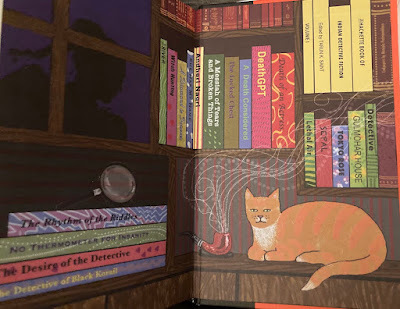 In all, this is a great-looking pair of books, a collector’s item for the aesthete, with an appealing cover illustration (by Jose) that runs across both volumes when placed alongside each other, and an endpaper design by Manjula Padmanabhan that should bring special pleasure to cat-lovers. Similar attention could have been paid to some of the inside layouts, though: a big let-down is that the original section breaks in Vikram Chandra’s story are entirely missing, which can create some confusion if you’re a first-time reader. (Having read it a couple of decades ago, I was still confused by the way the text ran on and on – and briefly wondered if the story had been more stream-of-consciousness than I had remembered.) In this case, I had access to the original and could compare, but it did leave me wondering if there were other stories that were similarly treated. The copy-editing is a bit slapdash in places, too – in the sense that there has been no real effort to smoothen the prose, insert missing articles, or remove the little typos in the pieces that were carelessly written or hurriedly submitted to begin with.
In all, this is a great-looking pair of books, a collector’s item for the aesthete, with an appealing cover illustration (by Jose) that runs across both volumes when placed alongside each other, and an endpaper design by Manjula Padmanabhan that should bring special pleasure to cat-lovers. Similar attention could have been paid to some of the inside layouts, though: a big let-down is that the original section breaks in Vikram Chandra’s story are entirely missing, which can create some confusion if you’re a first-time reader. (Having read it a couple of decades ago, I was still confused by the way the text ran on and on – and briefly wondered if the story had been more stream-of-consciousness than I had remembered.) In this case, I had access to the original and could compare, but it did leave me wondering if there were other stories that were similarly treated. The copy-editing is a bit slapdash in places, too – in the sense that there has been no real effort to smoothen the prose, insert missing articles, or remove the little typos in the pieces that were carelessly written or hurriedly submitted to begin with.
While the quality of the stories understandably varies, for me there were only a couple of bona-fide disappointments, among them Mahendra Jakhar’s “The Devil of Delhi”, in which dull, carelessly structured sentences plod along one after the other (a conversation where the line “The devil tried to kill me” is followed by “This devil is dangerous, Phoolan” is fairly representative of the story’s dialogue). A solid, imaginative mystery might have salvaged it; instead we get a banal exposition involving drug dealing, and a staged murder that comes off as laughable in an age of DNA testing.
Then there is Sharatchandra Sarkar’s “Bravo! What a Theft”, first published in a Bengali magazine in 1895, and basically, as Saint mentions in his Introduction, a reworking of the Conan Doyle-Holmes story “The Beryl Coronet”. Little of note is added to the original plot (what might leap out at you are the plot loopholes – such as the fact that a father who has described his son as a wild, feckless good-for-nothing who can’t be trusted around money immediately informs that very son about a priceless ornament in a secret hiding place nearby) and I didn’t get the point of using a story that has been lifted wholesale. It also made me more conscious of the fact that among the translated works included in these books, there is a much too heavy emphasis on Bengali stories.
****
But to return to the initial point about a problem of plenty: speaking for myself, reading these two books for professional reasons – and with an interest in all sorts of crime writing, from old-world to avant-garde – I was glad about the variety on offer, and some of the better stories introduced me to writers whose work I wasn’t conversant with (among them Kehkashan Khalid, Salil Desai, Saad Z Hossain, Meeti Shroff-Shah, Ajay Chowdhury, Sumit Bardhan, Rajarshi Das Bhowmik, Navin Weeraratne and Vaseem Khan). This also makes the anthology representative and multi-faceted. A slight hitch, though, is that for the more casual reader with very defined tastes, who is looking only for a certain type of mystery, it may be hard to sieve through the contents and pick out what works for them.
A bit of open-mindedness can help, of course: such readers – if they are willing to be surprised and stirred – will find much worthy material. Though the books are organised by theme, some of the best stories blithely resist categorisation anyway. One of my favourites, Shirshendu Mukhopadhyay’s “When Goyenda Met Daroga” (translated into English by Debaditya Mukhopadhyay), is as much an absurdist or madcap comedy as anything else. It centres on the despairing efforts of a daroga (cop) to apprehend a dacoit named Jhaluram, so adept at evading capture that he often seems to be more myth than man – as a result of which the story gives us throwaway lines like “Sir, this coconut tree is not a tree, it’s Jhaluram in disguise” and “I have a feeling that this red cow is none other than Jhaluram.”
Eventually, once the daroga teams up with amateur sleuth Baradacharan, the dacoit proves surprisingly easy to contact – and yet, throughout, one senses that the point of the story isn’t so much to arrive at a resolution as to show us “good guys” and “bad guys” in a merry dance, spinning tall tales, trying out disguises, just having some fun with each other. By the time one character tells another about an attempt to steal the Taj Mahal, and to ship a portion of Mount Everest to America, you know the story’s value lies in the journey more than the destination. That’s true of most of the really gripping tales in this collection, whether they deal with flesh-and-blood sleuths in a personal crisis, a Himalayan tantrist trained in the occult arts, or an algorithm-based virtual world where detection means identifying patterns.
-----------------
(Earlier Scroll pieces here)
May 6, 2024
Announcing The Swinging Seventies, a book about 1970s Hindi cinema
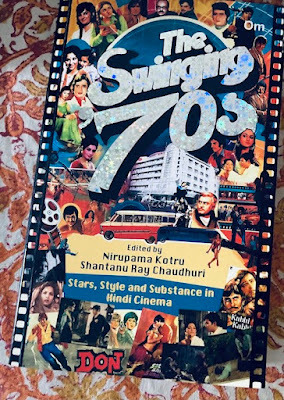 A big fat sumptuous book that means a great deal to us film-buffs associated with it (and should come to mean a lot to many readers) is out now: The Swinging Seventies, co-edited by Nirupama Kotru and Shantanu Ray Chaudhuri, is a collection of writings – from personal essays to interviews – centred on the Hindi cinema of that wide-ranging decade.
A big fat sumptuous book that means a great deal to us film-buffs associated with it (and should come to mean a lot to many readers) is out now: The Swinging Seventies, co-edited by Nirupama Kotru and Shantanu Ray Chaudhuri, is a collection of writings – from personal essays to interviews – centred on the Hindi cinema of that wide-ranging decade.In February this year Nirupama, Vishal Bharadwaj and I participated in a Jaipur Literature Festival discussion around the book, though it wasn’t yet available. Now it’s here, huge and gleaming, more than 600 pages, and with an impressive roster of contributors. We had a big launch at the India Habitat Centre on May 4, with as many of eleven of the writers present. Nirupama, Uday Bhatia, Gautam Chintamani, Kaveree Bamzai, Aseem Chhabra, Avijit Ghosh and I were on the panel, and many wise words were said (least of all by me – I kept my speech short). Here is a nice write-up about that event by the blogger/reviewer Arushi Barathi (this made me nostalgic about my early years in blogging, 20 years ago, when I used to write quite a bit about the events I attended, even if I wasn’t covering them professionally).
My piece in the book is a personal essay about a particular audio-cassette of my childhood, which also tries to make a broader point about the role that imagination plays in our film-watching, or in our engagement with cinema: what is it like, for instance, to listen to a film before you actually watch it? To construct a film in your own head. But there is plenty more in the book – you can gape at the contents pages and the list of contributors on the Amazon pre-order link, which is here. Please look out for the book, and spread the word to all the movie buffs you know (both those who love 1970s Hindi cinema *and* those who look down on it or are suspicious about its “relevance”).
Vignettes from Jaipur and Delhi below. And here is the link to our short session at JLF in February.
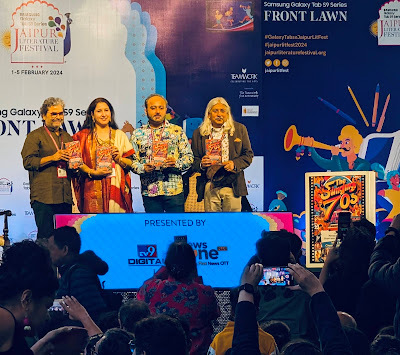
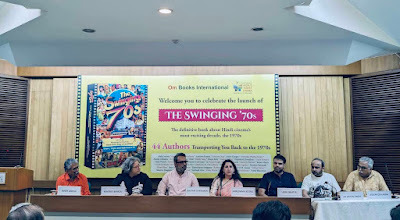
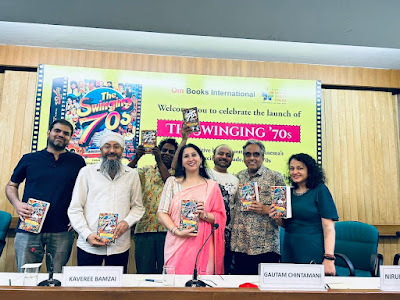
May 5, 2024
Motives, cues: on theatre, film, stardom and posterity
(wrote this for my Economic Times column)
-------------------------------
Filmed theatre – the recording and subsequent screening of a live stage production – isn’t to many tastes: it usually has neither the immediacy of a good play nor the kinetic visual appeal of a good film. I have been wary of the form ever since my school showed us an astonishingly dull “film” of The Merchant of Venice, which felt like it was created by having a stationary camera placed in the first row at a theatre.  And yet, I greatly enjoyed a recent screening – at Delhi’s India Habitat Centre – of The Motive and the Cue, Jack Thorne’s play about the inter-generational clashes between two major British actors – Sir John Gielgud and Richard Burton, during a 1964 Hamlet production in which the former directed the latter.
And yet, I greatly enjoyed a recent screening – at Delhi’s India Habitat Centre – of The Motive and the Cue, Jack Thorne’s play about the inter-generational clashes between two major British actors – Sir John Gielgud and Richard Burton, during a 1964 Hamlet production in which the former directed the latter.
One reason for this is that I’m a Hamlet-nut and have some interest in the real-life people portrayed here – especially Gielgud, marvellously played by Mark Gatiss (but also Burton and Elizabeth Taylor, who were newly married at the time, and who are mostly shown here in an apartment with pink-ish art design to emphasise their plastic, Hollywood-celebrity life). To fully appreciate this play, you probably need that interest. But even otherwise, The Motive and the Cue didn’t feel static to me. Cinematically you’d never mistake this for an Oppenheimer, of course, but it was thoughtfully put together: some of the establishing scenes were long-shots where you could see not just the entire stage but also part of the original theatre audience sitting in the dark; once a scene proper got underway and the camera “zoomed in” to the action, there were cuts and close-ups. Altogether, it was a strange, compelling experience – not “cinema” as one thinks of it, and yet a reminder that there have been so many different types of films, including the anti-narrative ones, or the Brechtian ones that call attention to their own construction. (I caught myself thinking of Lars von Trier’s Dogville, with its set design made up of painted, labelled outlines of furniture.)
Many of this play’s scenes are about plumbing Shakespeare’s verse for meaning and insight – an inflection here, a pause there, how one performer’s emphasis can be very different from another’s (and how each actor’s life experience – a relationship with a parent, for instance – might inform their approach to the scenes between Hamlet and his father’s ghost). What Gielgud tells Burton about the difference between the motive (the intellect or spine) and the cue (the passion, which ignites the heart) is a version of what Hamlet tells the players while setting his “mouse-trap” for the king.
Most of all, there are poignant moments here which make a case for the filmed-theatre form, in terms of preserving an important stage performance. The Motive and the Cue felt to me like a lament for all the great theatre of the past that was never recorded, and which we can only imagine now. Gatiss’s Gielgud at one point mentions that his major rival Laurence Olivier only played Hamlet on stage once, but will forever be remembered in the role because of his Oscar-winning film version (whereas Gielgud’s own legendary performances of the 1920s can no longer be revisited and exist only in imagination and anecdote). This play often touches on the insecurities of artists, constantly worrying about posterity (even when the present moment seems full of fame and attention), being unsure about their sell-by date. In one scene, almost certainly a fictionalised one, Gielgud and Elizabeth Taylor are chatting. “Can you imagine doing your best work at age 25?” he says ruefully, an allusion to the reputation he built, very young, as the greatest actor of his generation. “Can you imagine doing it at age 12?” Taylor replies sardonically – a reference to her performance as a child actor in the film National Velvet (during the shooting of which she also says she learnt Method Acting from Mickey Rooney, of all people!). Liz is one of the world’s biggest movie stars at this point, a recent Oscar-winner, and yet she and Burton seem very conscious that something valuable has been lost in terms of their integrity as performers; that after the media circus surrounding their affair during the Cleopatra shoot, they need to be more than just fodder for celebrity gossip. Maybe *they* need to do some Shakespeare together – The Taming of the Shrew?
This play often touches on the insecurities of artists, constantly worrying about posterity (even when the present moment seems full of fame and attention), being unsure about their sell-by date. In one scene, almost certainly a fictionalised one, Gielgud and Elizabeth Taylor are chatting. “Can you imagine doing your best work at age 25?” he says ruefully, an allusion to the reputation he built, very young, as the greatest actor of his generation. “Can you imagine doing it at age 12?” Taylor replies sardonically – a reference to her performance as a child actor in the film National Velvet (during the shooting of which she also says she learnt Method Acting from Mickey Rooney, of all people!). Liz is one of the world’s biggest movie stars at this point, a recent Oscar-winner, and yet she and Burton seem very conscious that something valuable has been lost in terms of their integrity as performers; that after the media circus surrounding their affair during the Cleopatra shoot, they need to be more than just fodder for celebrity gossip. Maybe *they* need to do some Shakespeare together – The Taming of the Shrew?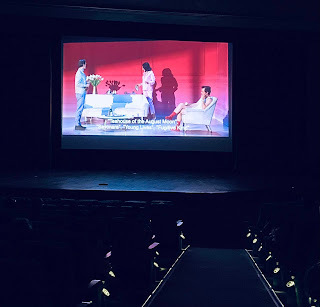 That film, made by Franco Zeffirelli a few years later, holds up well today; but it’s widely agreed that the bulk of the other films that Burton and Taylor did together were misfires. (The Leonard Maltin movie guide once “reviewed” their 1968 movie Boom! with the single word “Thud”.) In that sense, it feels like a cosmic joke that while many mediocre films are around forever (assuming anyone wants to seek them out), most great theatre is forever gone. Who is the really sympathetic figure in that interaction between Gielgud and Taylor, one can wonder: the stage legend depressed that there are few who remember his finest work, or the film-star concerned that the limelight is too harsh and persistent?
That film, made by Franco Zeffirelli a few years later, holds up well today; but it’s widely agreed that the bulk of the other films that Burton and Taylor did together were misfires. (The Leonard Maltin movie guide once “reviewed” their 1968 movie Boom! with the single word “Thud”.) In that sense, it feels like a cosmic joke that while many mediocre films are around forever (assuming anyone wants to seek them out), most great theatre is forever gone. Who is the really sympathetic figure in that interaction between Gielgud and Taylor, one can wonder: the stage legend depressed that there are few who remember his finest work, or the film-star concerned that the limelight is too harsh and persistent?
P.S. along with Gatiss, I thought Johnny Flynn (who plays another “Dickie” in the new Ripley series) was very good as Richard Burton. He doesn’t particularly look or sound like Burton initially, but he grows into the part enough that by the end I fancied I could see Burton’s features in his.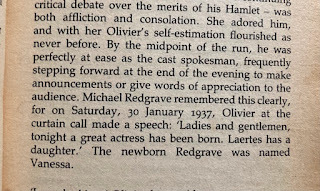 P.P.S. I also enjoyed the little reference to the birth of Vanessa Redgrave during a performance where her father Michael was playing Laertes to Olivier’s Hamlet on stage in 1937. I remembered the story from Donald Spoto’s Olivier book.
P.P.S. I also enjoyed the little reference to the birth of Vanessa Redgrave during a performance where her father Michael was playing Laertes to Olivier’s Hamlet on stage in 1937. I remembered the story from Donald Spoto’s Olivier book.
Jai Arjun Singh's Blog
- Jai Arjun Singh's profile
- 11 followers


